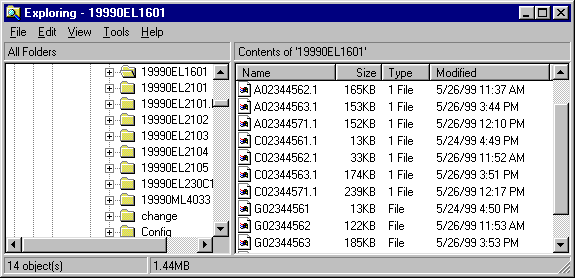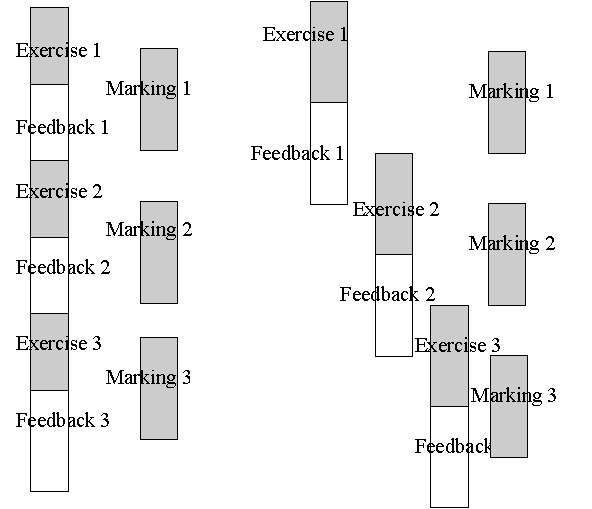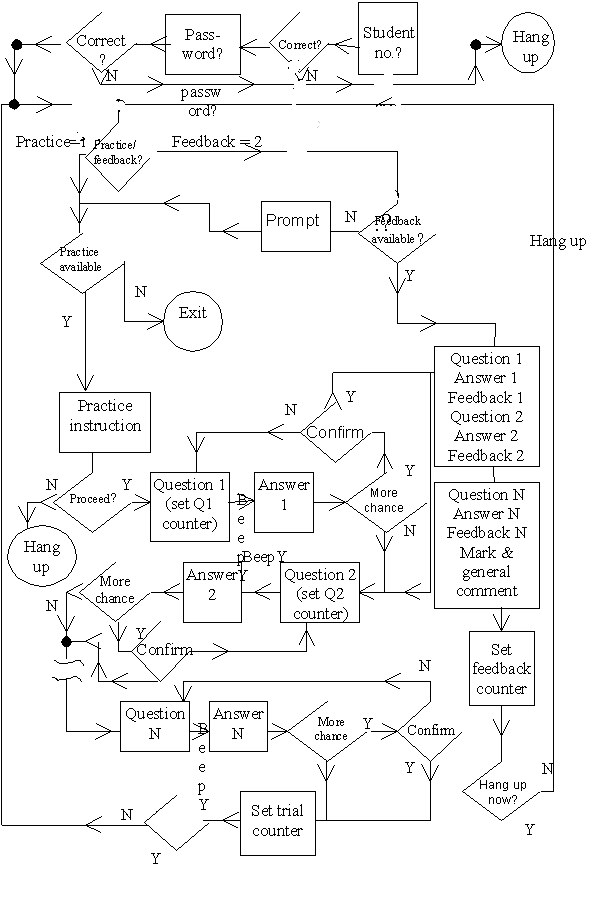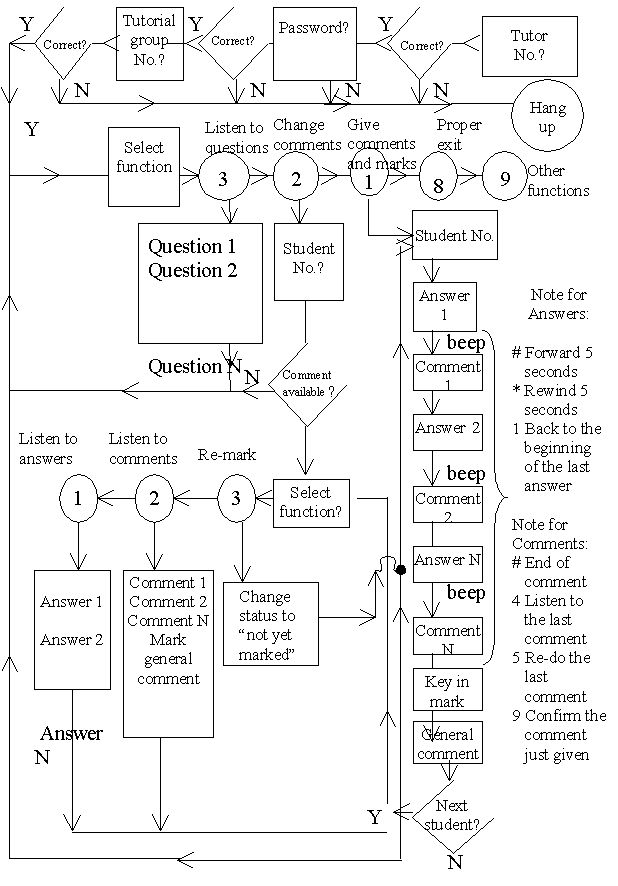| ITMELT '99 Conference |
|
On this site: Conference 1999 Home Page, Accepted Abstracts; Call for Papers; Hotel Accommodation, Conference Schedule.
The development, implementation and operation of the Computer Assisted Voice Mail Oral Practice System (CAVMOPS) at the Open University of Hong Kong
Anita Y.K. Poon, K.C. Tang & Thomas Tang
School of Education and Languages
The Open University of Hong Kong
Hong Kong
Introduction
This paper consists of four parts. The first part explains why there is a need for setting up the Computer Assisted Voice Mail Oral Practice System (CAVMOPS) for language learning at the Open University of Hong Kong (OUHK). The second part describes the design of the system. The third part focuses on the functions of the system. The final part demonstrates how such a system can enhance the oral skills of learners of English in the context of distance education.
Rationale for setting up CAVMOPS
In response to the Hong Kong government
’s biliterate and trilingual policy (Tung, 1997) and the high demand for university graduates who are proficient in both English and Chinese (Education Commission, 1990; Hong Kong Standard, 1989; Johnson, 1994; South China Morning Post, 1989), the OUHK has launched a number of language enhancement courses. Most of these courses involve elements that aim to help students to improve their oral language skills. To develop such skills, it is vital to provide students with as many opportunities as possible to practise speaking in realistic situations and to give them feedback on how they speak, since language skills, speaking in particular, are acquired through constant interactive practice (Poon, 1999). However, by virtue of the nature and philosophy of distance learning, face-to-face interaction between the learner and the teacher is limited. Distance learners are typically working adults who may not be able to attend regular classes for language practice. It is against this background that the OUHK set up the CAVMOPS to facilitate the learning of speaking skills after carefully considering various kinds of Computer Assisted Language Learning (CALL) technology mainly because it can handle a large number of students (500 or more) in a cost-effective manner and because it fits in with the flexible study pattern of our working adult learners.Design of CAVMOPS
Using the computer managed voice mail system and the computer telephone system has become quite popular in the commercial sector in recent years and such technology is developing quickly. It is possible with minor modifications of some commercial systems to build a computer assisted voice mail oral practice system (CAVMOPS).
The present CAVMOPS at OUHK has 12 concurrent telephone lines and thousands of voice mailboxes with a capacity of 5 to 10 minutes each. It allows students to dial in, declare who they are by using the key pad, indicate what they would like to do, listen for information and record their responses as voice messages. Likewise, tutors can dial in, declare their identity, listen to the responses of the students, and simultaneously make comments in the format of voice mail, or award marks using the telephone keypad. These comments and marks are recorded as voice messages, and available for the students to dial in and retrieve at their own convenience (see Appendix A).
The system can operate 24 hours a day. There is also an interface to transfer tutors
’ information, students’ information, usage statistics and marks awarded between the CAVMOPS and the main OUHK database system. The capacity of non-volatile storage is up to half of a year. A back-up storage for students’ messages and tutors’ feedback in the last two to three-months is also available.Functions of the System
Course coordinators’ (CCs) platform
Setting questions
The system allows a maximum of five different courses to use the system at the same time. CCs are at the top of the system control hierarchy with access to the CAVMOPS on the OUHK campus and, through their office desktop computers (equipped with sound cards), are able to log into the system at any time.
A typical oral practice exercise usually lasts about four minutes, with six minutes as the maximum. It is usually designed and recorded by a CC using either the office telephone or a microphone connected to the sound card of the office desktop computer. The CC may set only one question that requires a lengthy answer, or a set of questions that require shorter answers. The number of questions in an oral practice session ranges from one to ten. Students should give their responses to the questions sequentially.
The system allows CCs to record several exercises for a particular course at one time, with a maximum of ten exercises within one year. The CCs can set different periods during which their tutors and students can access a particular exercise (see Appendix B). The system also allows CCs to set the number of times (e.g. 0, 1 or 2) that the students can re-enter the system to do a particular exercise.
Monitoring performance
The system allows CCs to monitor a particular student’s responses to a particular exercise. It also allows them to access a particular tutor’s feedback on the performance of a particular student in a particular exercise. CCs can identify the exact date, time and file size of each voice message (Figure 1).

Figure 1: Students and tutors’ voice files
Furthermore, the system allows CCs to view a report on the activities of both tutors and students (Figures 2 & 3).
Report by Exercise Year : 1999 Semester : 0 Course : EL160 Exercise : 1 Print date : 1999/8/24 Page : 1 Student No. Exercise completed Marks by Tutor Tutor comments 02344561 Y 25 Y 02344562 Y 9 Y 02344571 Y 9 Y 02344563 Y 9 Y Total : 4 |
Figure 2: Report by exercise
Report by Tutor
|
Backing up for evaluation and research
The system allows CCs to make backup copies onto CD-ROM’s, floppy disks, audio tapes, etc. of all the records of a particular course after its presentation. This backup can include questions, students’ responses, tutors’ comments and marks, and statistical reports.
Students’ platform
The full capacity of the system is around 3000 students for all five courses. The students can use their telephone sets at home to access the system. Every student is given a password. They have to key in their own course code, student number and password when accessing the system (Appendix A & C).
Once students get into the system, there are two options: 1) doing exercises; or 2) listening to tutor’s comments and marks (Appendix C).
Doing exercises
If students choose to do an exercise, they can listen to the questions and give their responses. Students are given zero, one or two chances to re-do the exercise, subject to the design of the exercise by the CC. Normally each exercise is accessible for a period of two weeks, and students cannot have access to it beyond the designated period of time (Appendix B).
Listening to tutor’s feedback
If students choose to listen to their tutor’s comments and marks, they can receive them in their phone-mail box. Students may have one or two chances to listen to their tutors’ feedback again, normally within a period of two weeks. Students cannot have access to the comments and marks beyond the designated period of time (Appendix B).
Tutors’ platform
The system allows access to a maximum of 100 tutors for all five courses. The tutors can use their telephone sets at home to access the system using a password. They have also to key in their own course code, staff number and password when accessing the system. (Appendix A & D).
Once tutors get into the system, there are two options: 1) listening to new messages; and 2) re-marking unretrieved old messages (Appendix D).
Marking new messages
If they choose (1), they can listen to the students’ answers, give their comments and award marks using the telephone keypad. The system sorts and queues up new messages from the students in the tutor’s mailbox before they listen to and comment on the new message. In other words, when a tutor dials in and selects the new messages, these messages will sequentially for marking.
The tutor first hears the identification number of the student, followed by the student's answer. The tutor can rewind and listen again to all or part of the student’s answer before giving comments and marks. A fast-forward function allows the tutor to skip blank or irrelevant messages, and also the questions. The tutor can then give comments and award marks using the keypad. After that, they can choose to confirm or delete the comments and marks just given. If the tutor chooses to confirm, the comments and marks will be recorded, and the message will become an old or marked message. Afterwards, a new message will pop up automatically. The tutor can choose to mark a new message, or to end the marking session by simply hanging up.
Re-marking unretrieved old messages
If tutors want to listen to a particular marked message, they can choose the second option: re-marking unretrieved old messages. They have to key in the student number and an old marked message can be re-marked as long as the student has not yet retrieved it. The system also allows tutors to rewind or fast-forward the marked messages.
Other functions
Tutors can get the following information on the number of students: 1) who have done the exercise; 2) whose answers have been marked; and 3) who have retrieved the tutors’ feedback. The system also allows them to obtain a list of students: 1) who have done the exercise; 2) whose answers have been marked; and 3) who have retrieved the tutors’ feedback. Finally, tutors can choose to get the mean score of the current exercise, and listen to the start date and end date of the whole exercise, the student access and the tutor access period (Appendix B).
Application of CAVMOPS to English Language Learning
One of our English language enhancement courses - English for Effective Communication: Listening and Speaking (EL210) - has been the first course to use the CAVMOPS to facilitate students’ speaking skills development. EL210 is a skills-based course. The CAVMOPS is built into the design of the course. During the process of writing the materials, the developer was trying to utilize the system to its full and make it serve the purpose of the course. After learning a certain speaking skill, students are asked to practise the skill. Since the provision of face-to-face tutorials is limited in distance education, the developer was left with very few options when designing speaking activities. One typical option is through the use of audio-tapes where students can be asked to record a presentation on a specified topic on an audio tape. Alternatively, some questions can be recorded on the audio-tape with some blanks in between that allow students time to answer the questions. A major setback of using audio-tape is that students can stop the cassette recorder at any time so as to do the recording again if it is a monologue. As for the question-type answers, students can also stop at any time they like. Their response to the questions is not instant, and thus not spontaneous and authentic.
By contrast, if we use the CAVMOPS to do the same exercises above, students will not have control over the questions. They are forced to do the presentation over a designated period of time, or answer the questions asked instantaneously and the situation is thus made more authentic. However, one limitation with this system is that it is impossible to set follow-up questions as the student’s answer cannot be predicted an so questions must be designed in such a way that one question follows the other irrespective of what the answers are. A simulated conversation can thus take place.
The CAVMOPS is suitable for practising some speaking skills, but not others. If interaction and instant response are required, only some lower order speaking skills such as describing, explaining, narrating and reporting can be practised through the CAVMOPS. Higher order speaking skills such as discussing, arguing and negotiating cannot be applied. On the other hand, if interaction is not involved, the CAVMOPS is an effective means to practise the skills such as persuading, making presentations
, and the like.Three types of CAVMOPS exercise
We will now look at the following three types of CAVMOPS exercise written for EL210. The first type is interactive and immediate response from the student is required. Revision of some micro-skills for explaining and describing, for instance, placement and sequencing, use of transitions and repetitions, which are covered in Unit 1 of the course, is needed. However, it is not necessary for students to make any prior preparation of specified language structure or expressions for this particular exercise. When the students dial in the CAVMOPS, they hear the message in Figure 4.
A friend of yours called you up the other day and enquired about your university. He/she took the HKCEE 15 years ago and got only five passes, has been working in a trading firm as senior clerk, and is now looking for ways to upgrade his/her qualifications. Introduce the Open University to your friend. Now listen to your friend’s questions and answer them. You will hear a beep after each question. Start your recording after the beep. Altogether you have only two chances of recording your answers for this activity. I’ve heard that the OUHK is different from other universities in Hong Kong. Can you tell me the difference? * I graduated from F.5 fifteen years ago. Do you think I’m qualified to enrol in OU? * As you know, I’ve been a senior clerk in a trading company for a number of years. What courses I can take? * How many credits should I get in order to graduate from an honours degree programme? * How much do I need to pay? * |
Figure 4: CAVMOPS activity 1.14
The second type of CAVMOPS exercise is interactive and immediate response from the student is required. Revision of some micro-skills for telephoning, for example, making preparations, skills to start a call, to continue a call and to end a call, which are included in the course unit, is needed. This activity also requires students to make prior preparation of some special expressions learnt in the unit. It is tightly built into the course unit and serves as drilling practice. The following is taken from Unit 4 of the course:
Starting a call Once you are prepared, you can make your phone call. There are several possible scenarios. For example, you may be lucky enough to get the person you want; the person may not be available; your call may be picked up by an answering machine; you may get the wrong call. The following activities simulate these situations. As well as listening to your tape, you need to access the University’s CAVMOPS to complete them. Activity 4.1 In this activity you will hear the beginning of a telephone conversation. The caller gets through to the person she wants to speak to. Listen to the tape, and write down the sentence used by the receptionist to start the call. Now access CAVMOPS. Activity 4.2 This is another version of the telephone conversation. This time, the person May wants isn’t available. Listen to the tape, write down the sentence used to indicate the person isn’t available. Now access CAVMOPS for further practice. Activity 4.3 In this activity, May calls the travel agency only to find that she is answered by a recorded message. Some people find it a rather nerve-racking experience to listen and talk to an answer phone. You have to comprehend and summarize the recorded message, and at the same time organize, compose and record your own message within a few seconds. Once again, listen to the tape, and write down the message given on the answering machine. Now access CAVMOPS to practise leaving a message on an answerphone. |
Fi
gure 5: EL210 activities 4.1 – 4.3When the students do the activities in the unit, they will listen to the recording on the tape that accompanies the unit. After they familiarize themselves with the expressions used in the telephone conversation, they can access the CAVMOPS for further drilling of the expressions learnt. For example, Figure 6 outlines the CAVMOPS exercise for Activity 4.1.
| 1. This Oral Practice comprises three activities in Unit 4. Each activity is a short conversation between a receptionist and a customer. You will play the role of either the receptionist or the customer. Listen to the instruction on the phone and respond to the words spoken by the receptionist or the customer accordingly. Start recording after the beep. 2. Before accessing the system, you must do Activities 4.1-4.3 in Unit 4 in order to familiarize yourself with the language used in these activities. 3. You have altogether two chances of recording your answer for this exercise. Activity 4.1 You’ll hear the receptionist speak the same words as you heard just now in the conversation. Imagine you were the caller May Chan. Talk to the receptionist using a different expression but at the same time keeping the same meaning. Receptionist: Good morning, Travel Mate. Can I help you? * May: … Receptionist: Er, may I know who’s calling? * May: … Receptionist: I’ll put you through. * |
Figure 6: CAVMOPS activity 1.4
The third type of CAVMOPS exercise is non-interactive. Revision of some micro-skills for persuading others, for instance, using reasons to persuade, using emotion to persuade, using persuasive language (e.g. rhetorical questions, owned language, concrete language), which are covered in Unit 2 of the course is needed. However, students do not need to make any prior preparation of specified language structure or expressions for this particular exercise. The following is the message on the CAVMOPS:
Have you revised the skills for persuading others in Unit 2 ? If you haven’t done so, please hang up and dial in later. Altogether you have only two chances of recording your answer for this activity. Now listen to the question: Your father is a heavy smoker. Persuade him to give up smoking. Your speech should last 2-3 minutes. You have 30 seconds to prepare your speech. (Pause) Please start your recording after the beep. |
Feedback from tutors and students
Tutors’ evaluations of CAVMOPS (Poon, 1999) indicate that the tutors generally support its use. They think that it is a good idea to install the CAVMOPS and incorporate it in the course. They also feel that the system definitely helps to enhance students’ opportunities of practising oral skills and increase interactivity in language learning.
The students’ feedback is, however, mixed. A detailed analysis of the data indicates that those who are positive towards the system support it because such a system is seen as beneficial. Those who criticize it refer to the implementation of the system. Since EL210 is the first course to adopt the CAVMOPS, problems were bound to arise during its initial phase of implementation. There have been complaints about things such as difficulty of access, sudden disconnection from the system, inability to record messages, etc.. All these are teething problems of a new system, which still needs debugging. Some problems have also been due to inappropriate use of the system on the part of the students. For example, some students speak too fast or too slowly, others forget to press the # key when finished – problems which are impossible to predict.
Conclusion
We have discussed the rationale for choosing a computer assisted system that allows instantaneous and more interactive communication in language learning, which distance learners particularly need given the constraint of distance education. We have also described the system design and various functions of the system with reference to the coordinator, the student and the tutor. Finally, we have discussed how an English enhancement course has incorporated the CAVMOPS into its the course design so as to enhance students
’ opportunities of practising speaking skills in an authentic situation albeit the nature of interaction is asynchronous.As the CAVMOPS is a developing system, we have not yet conducted any evaluation on the system as a whole, except to gather some feedback from the users of the system. It is hoped that a formal evaluation on the CAVMOPS, which will lend itself to the upgrading of the system, will be in place in the near future.
References
Education Commission (1990). Education Commission Report No. 4. Hong Kong: Government Printer.
Hong Kong Standard. (1989, March 23). Swire calls for improvement in the standard of English.
Johnson, R.K. (1994). Critical Review of Literature on Language in Education in Hong Kong. Report prepared for the Education Commission Working Group on Language Proficiency.
Poon, A.Y.K. (1999). A challenge for the developer: Development of a language enhancement course in distance education. Paper presented at the 13th Annual Conference of the Asian Association of Open Universities held in Beijing, 1999.
South China Morning Post. (1989, January 16) Stopping the rot.
South China Morning Post. (1989, June 26) Bank chief to stress need for better English.
South China Morning Post. (1989, July 27) Warning on lack of English-fluent staff.
Tung, C.H. (1997). Policy speech of the Chief Executive of the Hong Kong SAR government delivered to the Legislative Council in October, 1997. Hong Kong: Information Services Department.
Appendix A:
General Flow Chart
Appendix B

Appendix C: Students’ flow chart

Appendix D: Tutors’ flow chart
